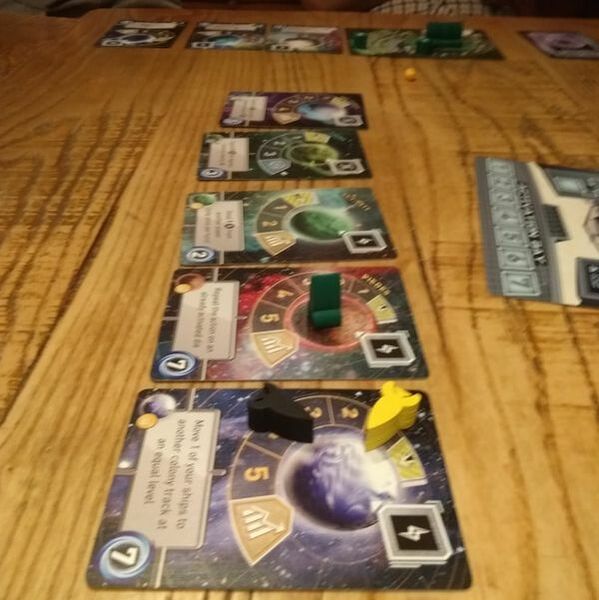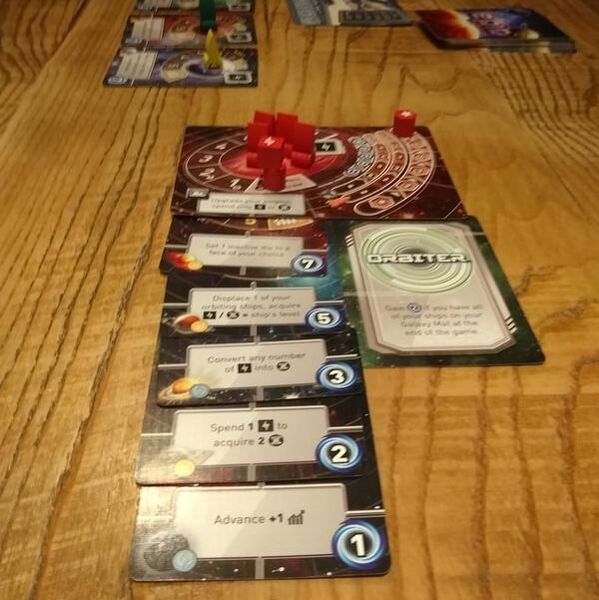|
26th February 2nd game of the night at 'The Sovs'. Tiny Epic Galaxies is a part of the 'Tiny Epic' line of games from Gamelyn. I guess that all of these games aim to deliver epic gameplay in a tiny box? Does Tiny Epic Galaxies deliver on this? See below. Well, it comes in a tiny-ish box, so that's a good start. Tiny Epic Galaxies is a card and dice game that combines elements of worker placement with push your luck to make a game about galactic exploration and expansion. Infact exploration and expansion are how you earn nearly all your victory points - and of course, the highest victory points wins the games. Set up To start with, each player is given their own 'galaxy mat'. The galaxy mat is used to track 3 scores. Energy, culture & galactic level (all explained below). Next, each player is given 2 secret mission cards, they then choose one to keep hidden face down next to or under their galaxy matt. The unused card is discarded. Then planet cards are dealt face up in a line. These represent newly discovered planet that players can exploit or colonise. Planet cards are explained in detail below, but it's worth noting here that there are always more planets available than players (by 1 or 2). Finally the control mat and the dice are placed where everyone can reach them. How to play Very simply: You roll the dice and then carry out the actions displayed on the dice. I think it's simpler to explain what some things do, then how play goes. Let's start with the galaxy mat.
Planets There are a number of features on every planet, all of them important.
Control mat
Dice rolling
When rolling the dice, player's will roll 4-7 dice (dependent on the level of their galaxy), all the dice are identical and have 6 different symbols. These are:
Rerolling dice After rolling their dice, the player can choose to re-roll some or all of the dice they just rolled. A player can choose to re-roll 2 or more times, but each additional re-roll after the first will cost a point of energy. There you have it, more or less all the rules. Play continues until a player's victory points reaches 21 or higher, this triggers the end game. Play then continues until all players have had an equal number of turns and then points are totted up. At this time players reveal their secret missions, if the objective is met, the the points are added to the player's total. Secret missions tend to add 2-3 victory points to the total, which is about 10-15%, so not insubstantial. I've played Tiny Epic Galaxies several times now and I always enjoy it. There are 40 different planet cards and they always appear randomly. I've found that quite often judicious use of their special abilities can give you an edge. So you need to pay attention to which ones appear, they're more than just victory points and resource generators. Add to this the unpredictability of the dice and you have a game with a lot of genuine replayability. There is one thing I will mention and that is the potential of the 'culture generation' strategy. If you have at least 2 ships on planets that generate culture and keep at least a point of culture on your galaxy mat: Anytime another player activates a culture die, you can spend a culture die to follow them - and generate 2 culture, giving you a net gain of 1 culture at no outlay (other than the initial point of culture). You can do this as often as you want whenever someone else activates a culture die with absolutely no drawback. Now this does requires a particular set of circumstances to occur, but they are not too uncommon (we encountered it the 1st or 2nd time we played it entirely by accident): I'm not sure if it's overpowered or not. It feels like it straddles the line between genuine strategy and exploit so I'm not too certain whether it's a legitimate criticism or not. Ah well. Despite that potential issue, I think it's still a good game to play. Is it epic? Well it's certainly good, although Tiny Good Galaxies' probably doesn't have the same ring to it!
0 Comments
Leave a Reply. |
AuthorI play, I paint. Archives
March 2024
Categories
All
|



 RSS Feed
RSS Feed
